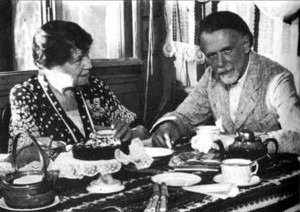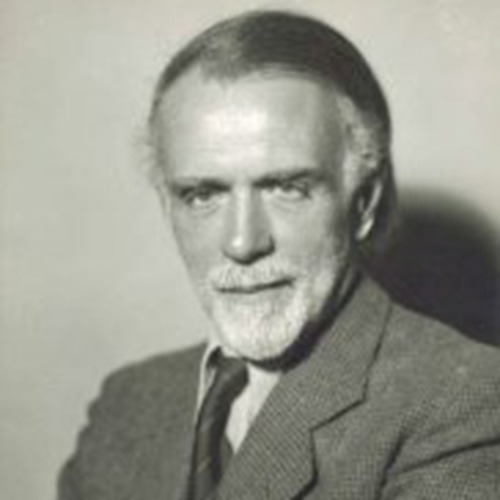 The most important and influential address for artistic matters at the turn of the 20th century Budapest was the salon of Emma Gruber. Mrs. Gruber was born Emma Schlesinger in the southern Hungarian town of Baja, daughter of wealthy merchants. To conceal their Jewish origins, the family changed their name to Sándor. All three Sándor children were highly musical, and Emma received piano and vocal lessons at a very young age. In addition, she quickly became an accomplished composer, and focused her creative activities on Lieder and works for piano. Once she arrived in Budapest with her banker husband Henrik Gruber, she took piano lessons with Ernst von Dohnányi, and received instruction in composition, first from Béla Bartók, and from February 1905, from Zoltán Kodály. An exceptionally well educated and inspiring woman and accomplished musician, her salon quickly became the center of cultural life.
The most important and influential address for artistic matters at the turn of the 20th century Budapest was the salon of Emma Gruber. Mrs. Gruber was born Emma Schlesinger in the southern Hungarian town of Baja, daughter of wealthy merchants. To conceal their Jewish origins, the family changed their name to Sándor. All three Sándor children were highly musical, and Emma received piano and vocal lessons at a very young age. In addition, she quickly became an accomplished composer, and focused her creative activities on Lieder and works for piano. Once she arrived in Budapest with her banker husband Henrik Gruber, she took piano lessons with Ernst von Dohnányi, and received instruction in composition, first from Béla Bartók, and from February 1905, from Zoltán Kodály. An exceptionally well educated and inspiring woman and accomplished musician, her salon quickly became the center of cultural life.
Among the guests at her home were well-known musicians and professors of the Budapest Academy, alongside music students, musicians and composers who often tried out their upcoming concert programs or introduced new compositions. She was perhaps the only musician at the time who recognized the talents of a young Béla Bartók, and she immediately learned and performed his newest compositions. Providing intelligent criticism, she was highly supportive of Bartók’s youthful career. As Bartók later wrote, “what an idea that I am not on good terms with Mrs. Gruber! On the contrary, if with anybody, then with her, that is, it is only with her that I am really on good terms. She is my sole friend, who wants the best for me in every respect.” When Kodály returned from Paris he brought with him the music of Debussy and the French impressionists. And he became a fixture in the Gruber salon.
The artistic friendship between Gruber, Bartók and Kodály also shared a strong interest in folk music. From 1906, Bartók and Kodály ventured on fieldtrips to the Hungarian countryside, collecting folk songs and recording them on phonograph cylinders. Mrs. Gruber owned a sizable collection of musical scores, among them countless volumes of folksongs from all parts of Europe. She had always been a folksong enthusiast and most of her compositions followed in that vein. Bartók clearly knew a number of Emma’s settings since he included two of them in his fourth book of his For Children. She actually contributed to this publication by translating the original Slovak works of the melodies into German. And it was through their shared love of folksong that Kodály fell in love with Emma Gruber, 20 years his senior. The feeling was reciprocal, and Emma left her husband to marry Zoltán on 3 August 1910. As a wedding present, Bartók made a phonograph recording, and he presented his Slovak arrangements from For Childern to Mr. and Mrs. Kodály.
Emma and Zoltán were deliriously happy and harmoniously married for 48 years! What is more, Emma became Kodály’s greatest collaborator. She was instrumental in all his musical and educational endeavors, and in a little forward for one of her compositions he wrote, “these melodies may reflect a few personal traits of a most remarkable woman, the beloved companion of my life. Her music was just an organic part of her life. She was a phantom of delight for everybody who met her.” Kodály wrote the Missa Brevis between 1942 and 1945, during the height of the Nazi invasion of Hungary. The work premiered in the cloakroom of the Budapest Opera House while the city was under siege in February 1945. Characterized by rich melodic inventions that borrows from Hungarian folk intonation, the Mass is dedicated to Emma, in celebration of their 35th wedding anniversary. Emma passed away on 22 November 1958 at the age of 95. A year later, Kodály married Sarolta Péczely, his 19-year-old godchild and student at the Franz Liszt Academy of Music with whom he lived happily until his death in 1967 at the age of 84 in Budapest.
Zoltán Kodály: Missa Brevis
You May Also Like
-
 Zoltán Kodály Zoltán Kodály (1882-1967) is widely considered the perfect embodiement of the Hungarian spirit.
Zoltán Kodály Zoltán Kodály (1882-1967) is widely considered the perfect embodiement of the Hungarian spirit.
More Love
-
 The Top Ten Loves of Franz Liszt’s Life Marie d'Agoult, Lola Montez, Marie Duplessis and more
The Top Ten Loves of Franz Liszt’s Life Marie d'Agoult, Lola Montez, Marie Duplessis and more - Mathilde Schoenberg and Richard Gerstl
Muse and Femme Fatale Did the love affair between Richard Gerstl and Mathilde Schoenberg served as a catalyst for Schoenberg's atonality? - Louis Spohr and Marianne Pfeiffer
Magic for Violin and Piano How did pianist Marianne Pfeiffer inspire a series of chamber music? - Louis Spohr and Dorette Scheidler
Magic for Violin and Harp "Shall we thus play together for life?"



There are now some recordings of some of her compositions.